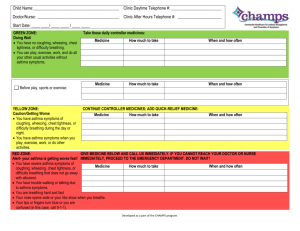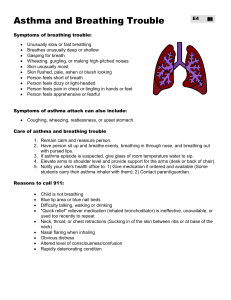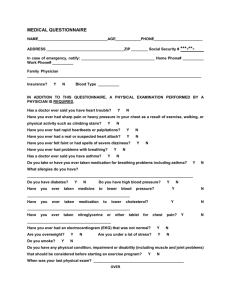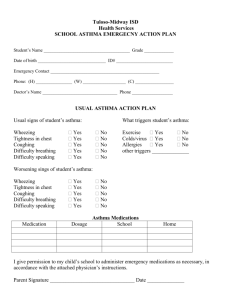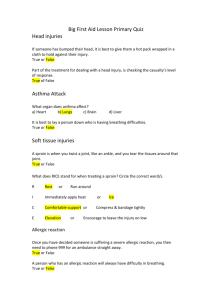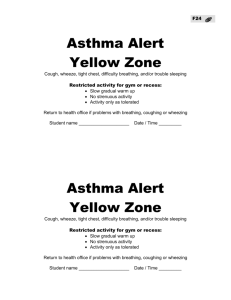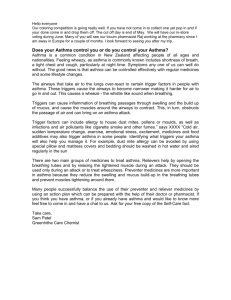Evidence about common complementary therapies for asthma
advertisement
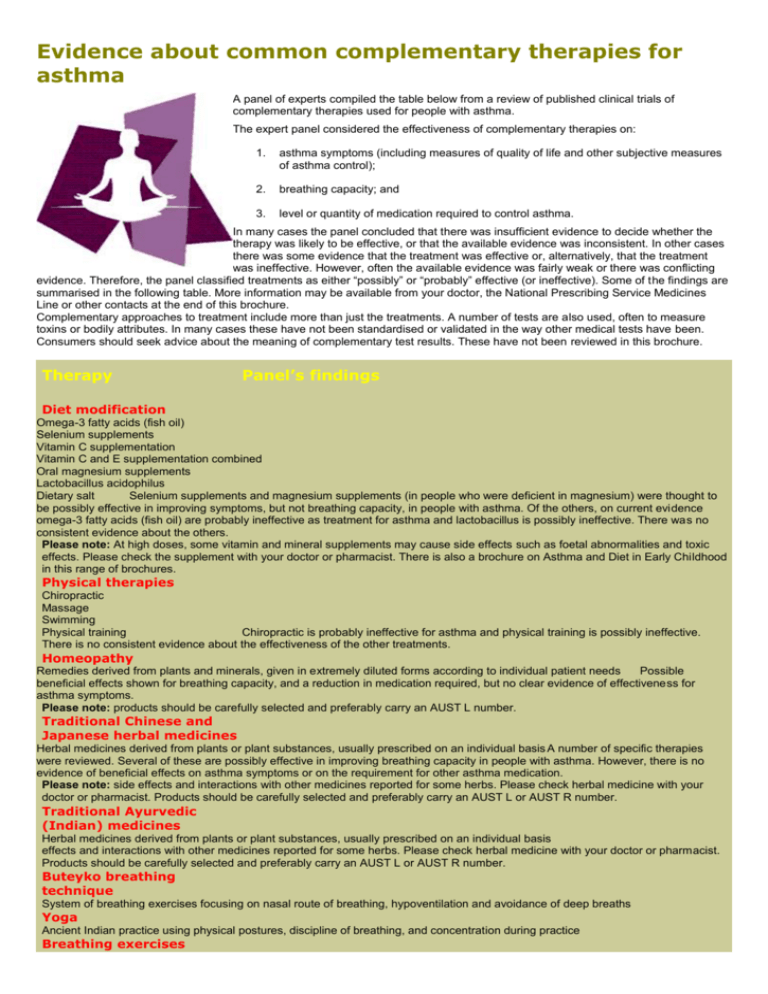
Evidence about common complementary therapies for asthma A panel of experts compiled the table below from a review of published clinical trials of complementary therapies used for people with asthma. The expert panel considered the effectiveness of complementary therapies on: 1. asthma symptoms (including measures of quality of life and other subjective measures of asthma control); 2. breathing capacity; and 3. level or quantity of medication required to control asthma. In many cases the panel concluded that there was insufficient evidence to decide whether the therapy was likely to be effective, or that the available evidence was inconsistent. In other cases there was some evidence that the treatment was effective or, alternatively, that the treatment was ineffective. However, often the available evidence was fairly weak or there was conflicting evidence. Therefore, the panel classified treatments as either “possibly” or “probably” effective (or ineffective). Some of the findings are summarised in the following table. More information may be available from your doctor, the National Prescribing Service Medicines Line or other contacts at the end of this brochure. Complementary approaches to treatment include more than just the treatments. A number of tests are also used, often to measure toxins or bodily attributes. In many cases these have not been standardised or validated in the way other medical tests have been. Consumers should seek advice about the meaning of complementary test results. These have not been reviewed in this brochure. Therapy Panel’s findings Diet modification Omega-3 fatty acids (fish oil) Selenium supplements Vitamin C supplementation Vitamin C and E supplementation combined Oral magnesium supplements Lactobacillus acidophilus Dietary salt Selenium supplements and magnesium supplements (in people who were deficient in magnesium) were thought to be possibly effective in improving symptoms, but not breathing capacity, in people with asthma. Of the others, on current evidence omega-3 fatty acids (fish oil) are probably ineffective as treatment for asthma and lactobacillus is possibly ineffective. There was no consistent evidence about the others. Please note: At high doses, some vitamin and mineral supplements may cause side effects such as foetal abnormalities and toxic effects. Please check the supplement with your doctor or pharmacist. There is also a brochure on Asthma and Diet in Early Childhood in this range of brochures. Physical therapies Chiropractic Massage Swimming Physical training Chiropractic is probably ineffective for asthma and physical training is possibly ineffective. There is no consistent evidence about the effectiveness of the other treatments. Homeopathy Remedies derived from plants and minerals, given in extremely diluted forms according to individual patient needs Possible beneficial effects shown for breathing capacity, and a reduction in medication required, but no clear evidence of effectiveness for asthma symptoms. Please note: products should be carefully selected and preferably carry an AUST L number. Traditional Chinese and Japanese herbal medicines Herbal medicines derived from plants or plant substances, usually prescribed on an individual basis A number of specific therapies were reviewed. Several of these are possibly effective in improving breathing capacity in people with asthma. However, there is no evidence of beneficial effects on asthma symptoms or on the requirement for other asthma medication. Please note: side effects and interactions with other medicines reported for some herbs. Please check herbal medicine with your doctor or pharmacist. Products should be carefully selected and preferably carry an AUST L or AUST R number. Traditional Ayurvedic (Indian) medicines Herbal medicines derived from plants or plant substances, usually prescribed on an individual basis effects and interactions with other medicines reported for some herbs. Please check herbal medicine with your doctor or pharmacist. Products should be carefully selected and preferably carry an AUST L or AUST R number. Severa Buteyko breathing technique System of breathing exercises focusing on nasal route of breathing, hypoventilation and avoidance of deep breaths Short-te Yoga Ancient Indian practice using physical postures, discipline of breathing, and concentration during practice Breathing exercises No con Various techniques effect on asthma symptoms. Possible beneficial effects on breathing capacity and medication requirement. No evidence of Acupuncture Laser or fine needles used to puncture the skin at defined points No con Hypnotherapy Creating a trance-like state No consistent evidence of beneficial effects in people with asthma. Ionisation Instrumentally boosting the positive and negative ion content of the air Probab Meditation Techniques used to calm the mind and body Possibl Music therapy Use of interactive music-making as a therapy to address individual emotional and developmental needs Possibl Osteopathy Physical manipulative therapy used to adjust misalignments of the muscles, joints and bones No con Reflexology Application of pressure, usually to the feet, to produce therapeutic effects on other parts of the body No con Speleotherapy A therapeutic measure which involves spending time in the pure underground air of caves or salt mines Possibl Relaxation therapy Techniques to reduce anxiety, tension and stress Probab
